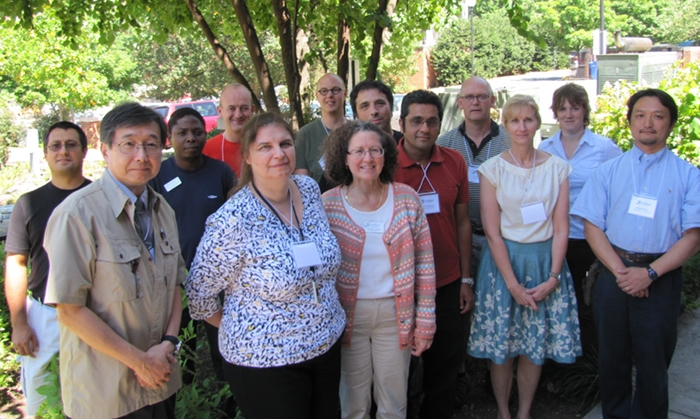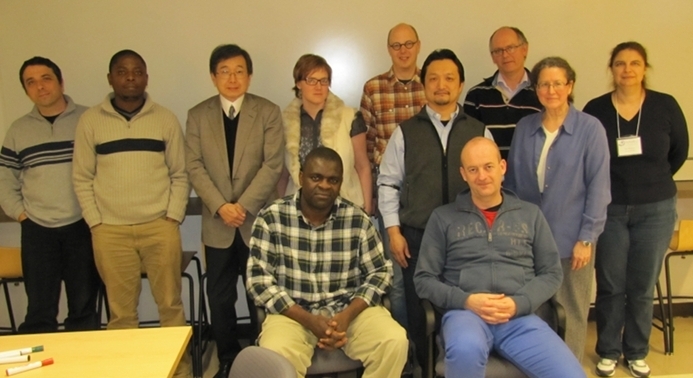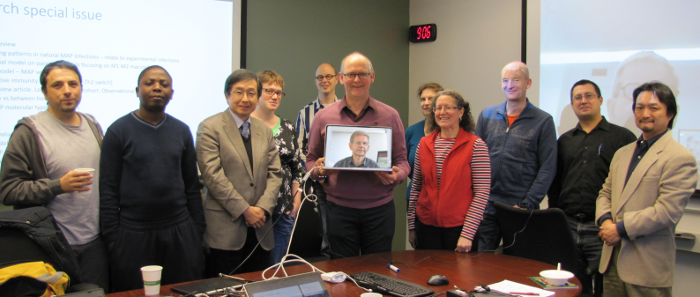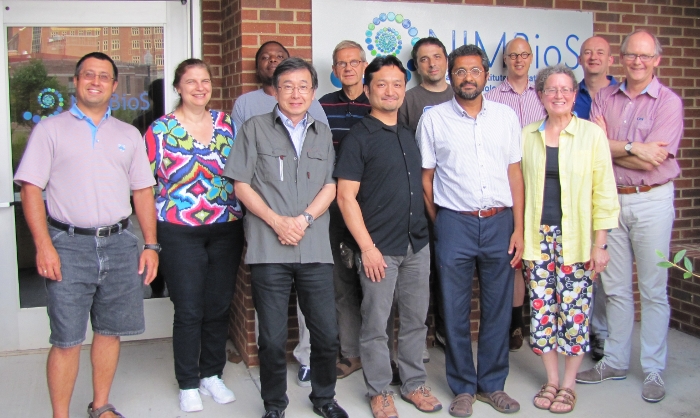| Description | Participants | Summaries | Products |
|---|
Archived NIMBioS Working Group
Within-host modeling of MAP infections

Topic: Within-host modeling of Mycobacterium avium subsp. paratuberculosis (MAP) infections
Meeting dates: June 26-28, 2012; March 4-6, 2013; December 9-11, 2013; July 20-23, 2014
Organizers:
Ynte H. Schukken (Cornell Univ., Ithaca, NY.)
Ad Koets (Utrecht Univ., the Netherlands)
Srinand Sreevatsan (Univ. of Minnesota)
Maia Martcheva (Univ. of Florida)
Shigetoshi Eda (Univ. of Tennessee)
Objectives. The NIMBioS working group on mathematical modeling of the within-host response to a Mycobacterium avium subsp paratuberculosis (MAP) infection is a logical consequence of a very successful NIMBioS investigative workshop on MAP held in the summer of 2011. This workshop highlighted the current state of our knowledge and clearly identified our lack of understanding of the within-host infection process of MAP. Empirical data on infection progression is present and multiple distinct infection patterns are present in MAP infected cattle. However, the immunological and microbiological attributes of infection and disease patterns are not well understood. There is a large amount of piece-meal immunological data available in previous publications and in the hands of MAP scientists. However these data have not resulted in a comprehensive understanding of the infection process. The objective of this working group is to develop a within-host MAP infection model, using observational data on infection patterns and within-host immune response data. The ultimate goal of the model is to provide an understanding of progression of disease in response to MAP infection and to devise better mitigation strategies for Johne's disease.

Meeting Summaries
| Mtg # | Dates | Agenda | Summary | Photo | Evaluation |
|---|---|---|---|---|---|
| 1 | Jun 26-28, 2012 | Link | Link | Report | |
| 2 | Mar 4-6, 2013 | Link | Link | ||
| 3 | Dec 9-11, 2013 | Link | Link | ||
| 4 | July 20-23, 2014 | Link | Link |
Meeting 1 Summary. The first meeting of the working group on within host modeling of Mycobacterium avium subsp. paratuberculosis (MAP) infections in bovine hosts was focused on obtaining an inventory of current immunological knowledge of the MAP infection process and the subsequent host response and an inventory of currently existing mathematical models of the within host infection process. The group then went on to develop three specific objectives. The first objective is to develop a position paper of our current understanding of the MAP infection process and the resulting host immune response. The second objective is to develop a collection of datasets on longitudinally followed MAP infection processes in individual animals and herds of animals and make these datasets available to the members of the working group. The third objective is to develop a conceptual mathematical model of the MAP infection process and the host immune results that models the biological process of a steady state MAP infection in a host without triggering an immune response that results in heavy fecal shedding and immune-pathologies.
Meeting 2 Summary. The second meeting of the working group on within host modeling of Mycobacterium avium subsp. paratuberculosis (MAP) infections in bovine hosts was focused on further development of the initial set of mathematical models describing within host dynamics of MAP infection. The working group discussed three alternative mathematical models on within host MAP infection dynamics. The working group will further develop these models and evaluate the predictive ability of the models against observed shedding patterns of MAP. The working group has collected a series of longitudinal data sets and MAP shedding and will analyze these data to identify a number of 'typical' shedding patterns. A series of papers is planned by the group on both quantitative pathobiology and mathematical models. The working group will continue its monthly conference calls and plans to meet again in the fall of 2013.
Meeting 3 Summary. The third meeting was focused on further development of a series of mathematical models describing within host dynamics of MAP infection. First, the Working Group defined two "typical" shedding patterns of MAP. The two patterns consist of so called "progressors" and "non-progressors," representing animals that are destined at the time of infection to become high shedders or remain low and intermittent shedders respectively. The Working Group developed a series of four alternative mathematical models with increasing complexity on within-host MAP infection dynamics. The models were fitted against observed shedding patterns of MAP. The working group further expanded the collection of longitudinal data sets of both experimental and natural infections. A series of papers is planned for a special issue in Veterinary Research by the group on both quantitative pathobiology and mathematical models. Monthly conference calls will continue with the group, which plans to meet again in July of 2014 for a fourth and final meeting.
Meeting 4 summary. The fourth meeting focused on completion of a series of papers on within-host modeling of MAP infections. We pulled together a series of ten papers relevant to the work on the working group. The group also developed a series of five models on within-host infection dynamics of MAP with increasing complexity. The models were fitted against observed shedding patterns of MAP. We used a series of longitudinal data sets of both experimental and natural infections to fit data to the models and check the models for biological and epidemiological relevance. A set of key conclusions from the papers and models was summarized by the Working Group in an editorial for a dedicated special issue of the journal Veterinary Research on MAP within-host infection dynamics. The Working Group will continue its monthly conference calls until the special issue has been published. We also discussed options for future collaborations. The Working Group concluded by thanking the leadership team and staff of NIMBioS for facilitating our work. We were very satisfied with our group's progress and results.
 |
| MAP Working Group, Meeting 1. (From left): Vitaly Ganusov, Eiichi Momotani, Gesham Magombedze, Ad Koets, Maia Martcheva, Don Klinkenberg, Suzanne Lenhart, Yoram Louzoun, Srindand Sreevatsan, Ynte Schukken, Judy Stabel, Rebecca Mitchell, Shigetoshi Eda |
 |
| MAP Working Group, Meeting 2. (From left): Yoram Louzoun, Gesham Magombedze, Eiichi Momotani, Rebecca Mitchell, Don Klinkenberg, Shigetoshi Eda, Ynte Schukken, Suzanne Lenhart, Maia Marcheva. (Seated, from left): Calistus Ngonghala, Ad Koets |
 |
| MAP Working Group, Meeting 3. (From left): Yoram Louzoun, Gesham Magombedze, Eiichi Momotani, Rebecca Mitchell, Don Klinkenberg, Ynte Schukken, Yrjö Gröhn (via Skype), Maia Martcheva, Suzanne Lenhart, Ad Koets, Vitaly Ganusov, Shigetoshi Eda. |
 |
| MAP Working Group, Meeting 4. (L to R): Vitaly Ganusov, Maia Martcheva, Gesham Magombedze, Eiichi Momotani, Yrjö Gröhn , Shigetoshi Eda, Yoram Louzoun, Srindand Sreevatsan, Don Klinkenberg, Suzanne Lenhart, Ad Koets, Ynte Schukken. |
NIMBioS Working Groups are chosen to focus on major scientific questions at the interface between biology and mathematics. NIMBioS is particularly interested in questions that integrate diverse fields, require synthesis at multiple scales, and/or make use of or require development of new mathematical/computational approaches. NIMBioS Working Groups are relatively small (up to 10 participants), focus on a well-defined topic, and have well-defined goals and metrics of success. Working Groups will meet up to 3 times over a two-year period, with each meeting lasting up to 2.5 days.
A goal of NIMBioS is to enhance the cadre of researchers capable of interdisciplinary efforts across mathematics and biology. As part of this goal, NIMBioS is committed to promoting diversity in all its activities. Diversity is considered in all its aspects, social and scientific, including gender, ethnicity, scientific field, career stage, geography and type of home institution. Questions regarding diversity issues should be directed to diversity@nimbios.org. You can read more about our Diversity Plan on our NIMBioS Policies web page. The NIMBioS building is fully handicapped accessible.
NIMBioS
1122 Volunteer Blvd., Suite 106
University of Tennessee
Knoxville,
TN 37996-3410
PH: (865) 974-9334
FAX: (865) 974-9461
Contact NIMBioS


